Jinsong Su
Sigma-MoE-Tiny Technical Report
Dec 19, 2025Abstract:Mixture-of-Experts (MoE) has emerged as a promising paradigm for foundation models due to its efficient and powerful scalability. In this work, we present Sigma-MoE-Tiny, an MoE language model that achieves the highest sparsity compared to existing open-source models. Sigma-MoE-Tiny employs fine-grained expert segmentation with up to 96 experts per layer, while activating only one expert for each token, resulting in 20B total parameters with just 0.5B activated. The major challenge introduced by such extreme sparsity lies in expert load balancing. We find that the widely-used load balancing loss tends to become ineffective in the lower layers under this setting. To address this issue, we propose a progressive sparsification schedule aiming to balance expert utilization and training stability. Sigma-MoE-Tiny is pre-trained on a diverse and high-quality corpus, followed by post-training to further unlock its capabilities. The entire training process remains remarkably stable, with no occurrence of irrecoverable loss spikes. Comprehensive evaluations reveal that, despite activating only 0.5B parameters, Sigma-MoE-Tiny achieves top-tier performance among counterparts of comparable or significantly larger scale. In addition, we provide an in-depth discussion of load balancing in highly sparse MoE models, offering insights for advancing sparsity in future MoE architectures. Project page: https://qghuxmu.github.io/Sigma-MoE-Tiny Code: https://github.com/microsoft/ltp-megatron-lm
Towards Fine-Grained Code-Switch Speech Translation with Semantic Space Alignment
Nov 09, 2025Abstract:Code-switching (CS) speech translation (ST) refers to translating speech that alternates between two or more languages into a target language text, which poses significant challenges due to the complexity of semantic modeling and the scarcity of CS data. Previous studies tend to rely on the model itself to implicitly learn semantic modeling during training, and resort to inefficient and costly manual annotations for these two challenges. To mitigate these limitations, we propose enhancing Large Language Models (LLMs) with a Mixture of Experts (MoE) speech projector, where each expert specializes in the semantic subspace of a specific language, enabling fine-grained modeling of speech features. Additionally, we introduce a multi-stage training paradigm that utilizes readily available monolingual automatic speech recognition (ASR) and monolingual ST data, facilitating speech-text alignment and improving translation capabilities. During training, we leverage a combination of language-specific loss and intra-group load balancing loss to guide the MoE speech projector in efficiently allocating tokens to the appropriate experts, across expert groups and within each group, respectively. To bridge the data gap across different training stages and improve adaptation to the CS scenario, we further employ a transition loss, enabling smooth transitions of data between stages, to effectively address the scarcity of high-quality CS speech translation data. Extensive experiments on widely used datasets demonstrate the effectiveness and generality of our approach.
Probing Latent Knowledge Conflict for Faithful Retrieval-Augmented Generation
Oct 14, 2025Abstract:Retrieval-Augmented Generation (RAG) has emerged as a powerful paradigm to enhance the factuality of Large Language Models (LLMs). However, existing RAG systems often suffer from an unfaithfulness issue, where the model's response contradicts evidence from the retrieved context. Existing approaches to improving contextual faithfulness largely rely on external interventions, such as prompt engineering, decoding constraints, or reward-based fine-tuning. These works treat the LLM as a black box and overlook a crucial question: how does the LLM internally integrate retrieved evidence with its parametric memory, particularly under knowledge conflicts? To address this gap, we conduct a probing-based analysis of hidden-state representations in LLMs and observe three findings: knowledge integration occurs hierarchically, conflicts manifest as latent signals at the sentence level, and irrelevant context is often amplified when aligned with parametric knowledge. Building on these findings, we propose CLEAR (Conflict-Localized and Enhanced Attention for RAG), a framework that (i) decomposes context into fine-grained sentence-level knowledge, (ii) employs hidden-state probing to localize conflicting knowledge, and (iii) introduces conflict-aware fine-tuning to guide the model to accurately integrate retrieved evidence. Extensive experiments across three benchmarks demonstrate that CLEAR substantially improves both accuracy and contextual faithfulness, consistently outperforming strong baselines under diverse conflict conditions. The related resources are available at https://github.com/LinfengGao/CLEAR.
Training Matryoshka Mixture-of-Experts for Elastic Inference-Time Expert Utilization
Sep 30, 2025Abstract:Mixture-of-Experts (MoE) has emerged as a promising paradigm for efficiently scaling large language models without a proportional increase in computational cost. However, the standard training strategy of Top-K router prevents MoE models from realizing their full potential for elastic inference. When the number of activated experts is altered at inference time, these models exhibit precipitous performance degradation. In this work, we introduce Matryoshka MoE (M-MoE), a training framework that instills a coarse-to-fine structure directly into the expert ensemble. By systematically varying the number of activated experts during training, M-MoE compels the model to learn a meaningful ranking: top-ranked experts collaborate to provide essential, coarse-grained capabilities, while subsequent experts add progressively finer-grained detail. We explore this principle at multiple granularities, identifying a layer-wise randomization strategy as the most effective. Our experiments demonstrate that a single M-MoE model achieves remarkable elasticity, with its performance at various expert counts closely matching that of an entire suite of specialist models, but at only a fraction of the total training cost. This flexibility not only unlocks elastic inference but also enables optimizing performance by allocating different computational budgets to different model layers. Our work paves the way for more practical and adaptable deployments of large-scale MoE models.
LLM-OREF: An Open Relation Extraction Framework Based on Large Language Models
Sep 18, 2025Abstract:The goal of open relation extraction (OpenRE) is to develop an RE model that can generalize to new relations not encountered during training. Existing studies primarily formulate OpenRE as a clustering task. They first cluster all test instances based on the similarity between the instances, and then manually assign a new relation to each cluster. However, their reliance on human annotation limits their practicality. In this paper, we propose an OpenRE framework based on large language models (LLMs), which directly predicts new relations for test instances by leveraging their strong language understanding and generation abilities, without human intervention. Specifically, our framework consists of two core components: (1) a relation discoverer (RD), designed to predict new relations for test instances based on \textit{demonstrations} formed by training instances with known relations; and (2) a relation predictor (RP), used to select the most likely relation for a test instance from $n$ candidate relations, guided by \textit{demonstrations} composed of their instances. To enhance the ability of our framework to predict new relations, we design a self-correcting inference strategy composed of three stages: relation discovery, relation denoising, and relation prediction. In the first stage, we use RD to preliminarily predict new relations for all test instances. Next, we apply RP to select some high-reliability test instances for each new relation from the prediction results of RD through a cross-validation method. During the third stage, we employ RP to re-predict the relations of all test instances based on the demonstrations constructed from these reliable test instances. Extensive experiments on three OpenRE datasets demonstrate the effectiveness of our framework. We release our code at https://github.com/XMUDeepLIT/LLM-OREF.git.
Tool Graph Retriever: Exploring Dependency Graph-based Tool Retrieval for Large Language Models
Aug 07, 2025Abstract:With the remarkable advancement of AI agents, the number of their equipped tools is increasing rapidly. However, integrating all tool information into the limited model context becomes impractical, highlighting the need for efficient tool retrieval methods. In this regard, dominant methods primarily rely on semantic similarities between tool descriptions and user queries to retrieve relevant tools. However, they often consider each tool independently, overlooking dependencies between tools, which may lead to the omission of prerequisite tools for successful task execution. To deal with this defect, in this paper, we propose Tool Graph Retriever (TGR), which exploits the dependencies among tools to learn better tool representations for retrieval. First, we construct a dataset termed TDI300K to train a discriminator for identifying tool dependencies. Then, we represent all candidate tools as a tool dependency graph and use graph convolution to integrate the dependencies into their representations. Finally, these updated tool representations are employed for online retrieval. Experimental results on several commonly used datasets show that our TGR can bring a performance improvement to existing dominant methods, achieving SOTA performance. Moreover, in-depth analyses also verify the importance of tool dependencies and the effectiveness of our TGR.
FaithfulRAG: Fact-Level Conflict Modeling for Context-Faithful Retrieval-Augmented Generation
Jun 10, 2025



Abstract:Large language models (LLMs) augmented with retrieval systems have demonstrated significant potential in handling knowledge-intensive tasks. However, these models often struggle with unfaithfulness issues, generating outputs that either ignore the retrieved context or inconsistently blend it with the LLM`s parametric knowledge. This issue is particularly severe in cases of knowledge conflict, where the retrieved context conflicts with the model`s parametric knowledge. While existing faithful RAG approaches enforce strict context adherence through well-designed prompts or modified decoding strategies, our analysis reveals a critical limitation: they achieve faithfulness by forcibly suppressing the model`s parametric knowledge, which undermines the model`s internal knowledge structure and increases the risk of misinterpreting the context. To this end, this paper proposes FaithfulRAG, a novel framework that resolves knowledge conflicts by explicitly modeling discrepancies between the model`s parametric knowledge and retrieved context. Specifically, FaithfulRAG identifies conflicting knowledge at the fact level and designs a self-thinking process, allowing LLMs to reason about and integrate conflicting facts before generating responses. Extensive experiments demonstrate that our method outperforms state-of-the-art methods. The code is available at https:// github.com/DeepLearnXMU/Faithful-RAG
When to use Graphs in RAG: A Comprehensive Analysis for Graph Retrieval-Augmented Generation
Jun 06, 2025Abstract:Graph retrieval-augmented generation (GraphRAG) has emerged as a powerful paradigm for enhancing large language models (LLMs) with external knowledge. It leverages graphs to model the hierarchical structure between specific concepts, enabling more coherent and effective knowledge retrieval for accurate reasoning.Despite its conceptual promise, recent studies report that GraphRAG frequently underperforms vanilla RAG on many real-world tasks. This raises a critical question: Is GraphRAG really effective, and in which scenarios do graph structures provide measurable benefits for RAG systems? To address this, we propose GraphRAG-Bench, a comprehensive benchmark designed to evaluate GraphRAG models onboth hierarchical knowledge retrieval and deep contextual reasoning. GraphRAG-Bench features a comprehensive dataset with tasks of increasing difficulty, coveringfact retrieval, complex reasoning, contextual summarization, and creative generation, and a systematic evaluation across the entire pipeline, from graph constructionand knowledge retrieval to final generation. Leveraging this novel benchmark, we systematically investigate the conditions when GraphRAG surpasses traditional RAG and the underlying reasons for its success, offering guidelines for its practical application. All related resources and analyses are collected for the community at https://github.com/GraphRAG-Bench/GraphRAG-Benchmark.
A Multi-Agent Framework with Automated Decision Rule Optimization for Cross-Domain Misinformation Detection
Mar 30, 2025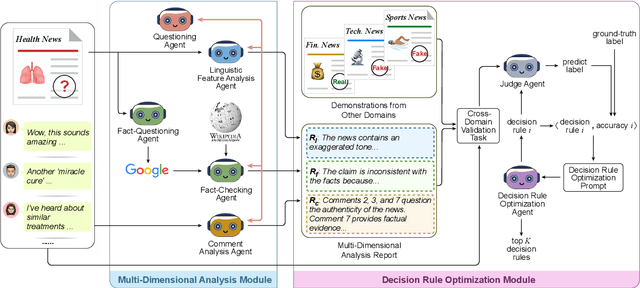
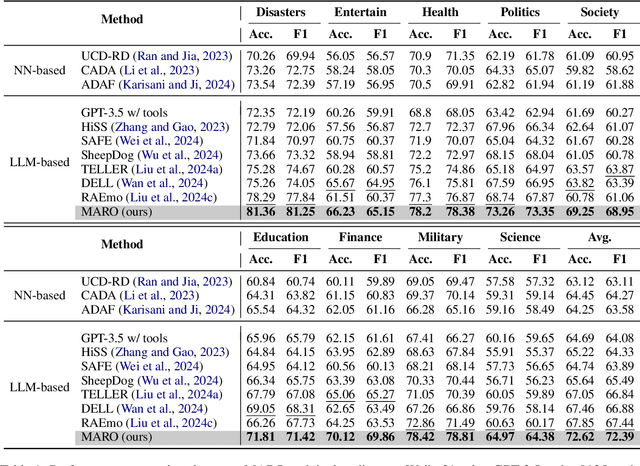
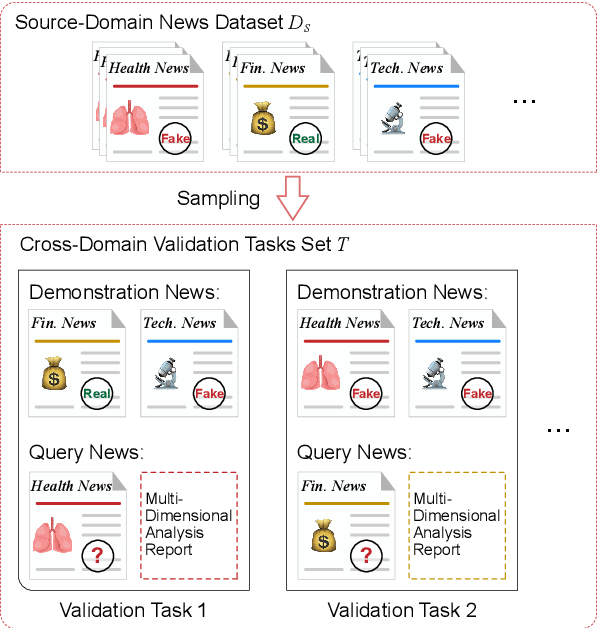
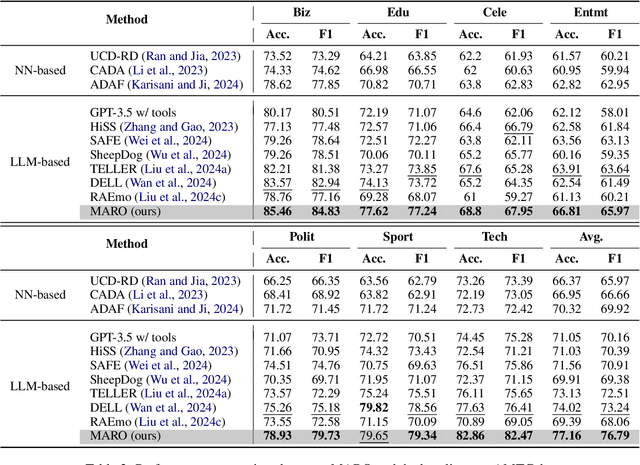
Abstract:Misinformation spans various domains, but detection methods trained on specific domains often perform poorly when applied to others. With the rapid development of Large Language Models (LLMs), researchers have begun to utilize LLMs for cross-domain misinformation detection. However, existing LLM-based methods often fail to adequately analyze news in the target domain, limiting their detection capabilities. More importantly, these methods typically rely on manually designed decision rules, which are limited by domain knowledge and expert experience, thus limiting the generalizability of decision rules to different domains. To address these issues, we propose a MultiAgent Framework for cross-domain misinformation detection with Automated Decision Rule Optimization (MARO). Under this framework, we first employs multiple expert agents to analyze target-domain news. Subsequently, we introduce a question-reflection mechanism that guides expert agents to facilitate higherquality analysis. Furthermore, we propose a decision rule optimization approach based on carefully-designed cross-domain validation tasks to iteratively enhance the effectiveness of decision rules in different domains. Experimental results and in-depth analysis on commonlyused datasets demonstrate that MARO achieves significant improvements over existing methods.
LLaVE: Large Language and Vision Embedding Models with Hardness-Weighted Contrastive Learning
Mar 04, 2025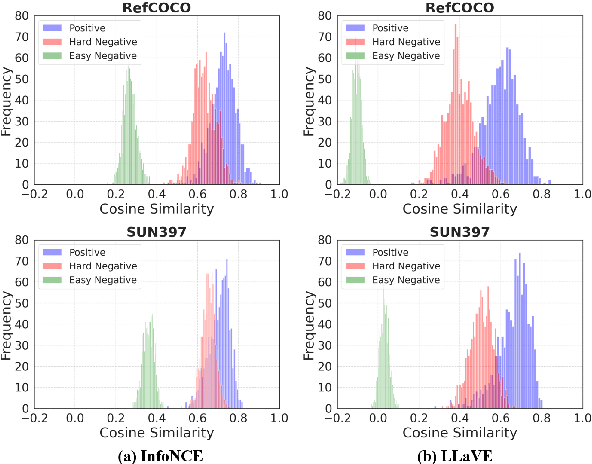
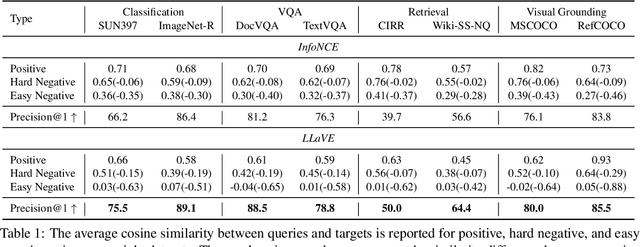
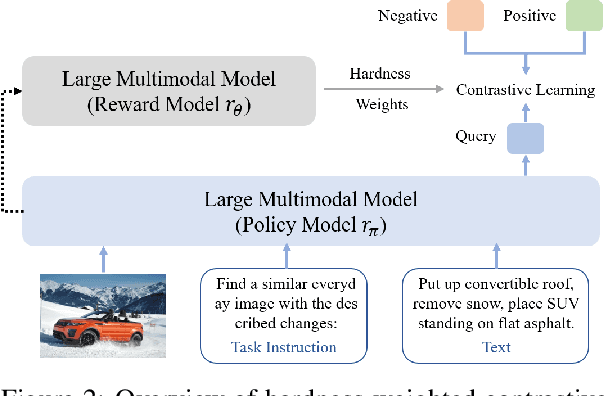
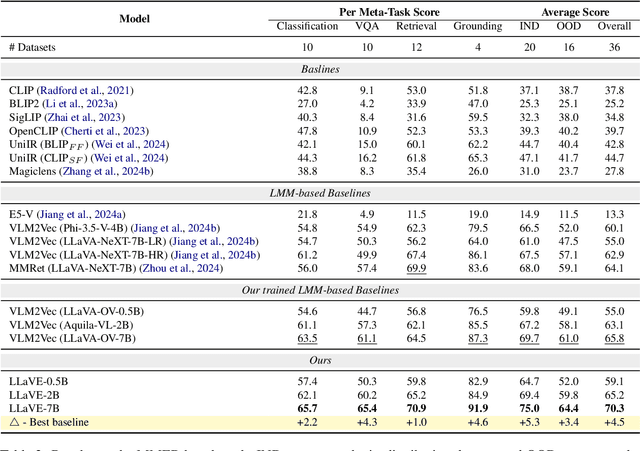
Abstract:Universal multimodal embedding models play a critical role in tasks such as interleaved image-text retrieval, multimodal RAG, and multimodal clustering. However, our empirical results indicate that existing LMM-based embedding models trained with the standard InfoNCE loss exhibit a high degree of overlap in similarity distribution between positive and negative pairs, making it challenging to distinguish hard negative pairs effectively. To deal with this issue, we propose a simple yet effective framework that dynamically improves the embedding model's representation learning for negative pairs based on their discriminative difficulty. Within this framework, we train a series of models, named LLaVE, and evaluate them on the MMEB benchmark, which covers 4 meta-tasks and 36 datasets. Experimental results show that LLaVE establishes stronger baselines that achieve state-of-the-art (SOTA) performance while demonstrating strong scalability and efficiency. Specifically, LLaVE-2B surpasses the previous SOTA 7B models, while LLaVE-7B achieves a further performance improvement of 6.2 points. Although LLaVE is trained on image-text data, it can generalize to text-video retrieval tasks in a zero-shot manner and achieve strong performance, demonstrating its remarkable potential for transfer to other embedding tasks.
 Add to Chrome
Add to Chrome Add to Firefox
Add to Firefox Add to Edge
Add to Edge